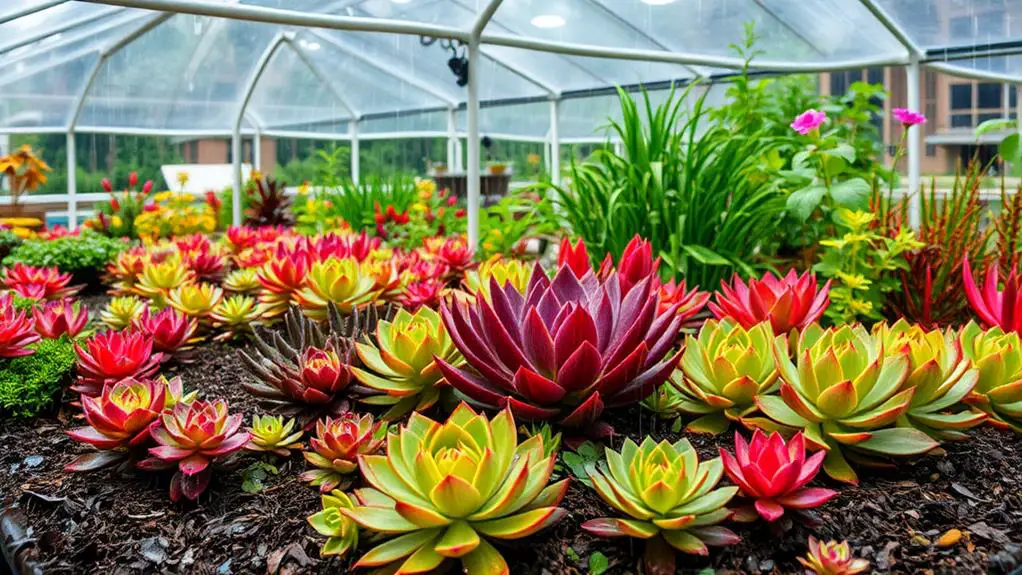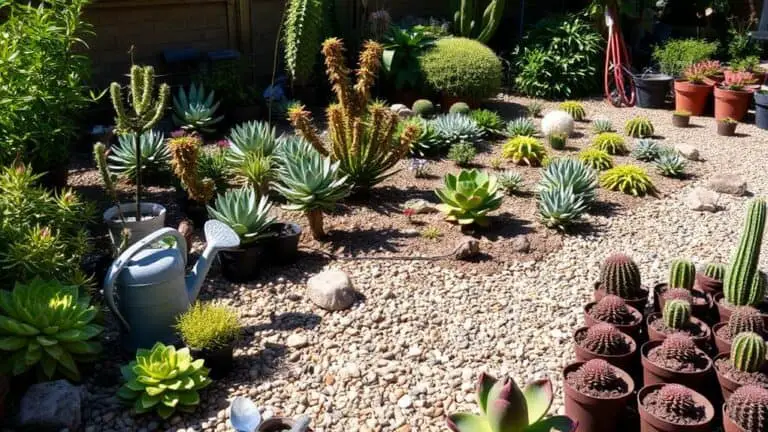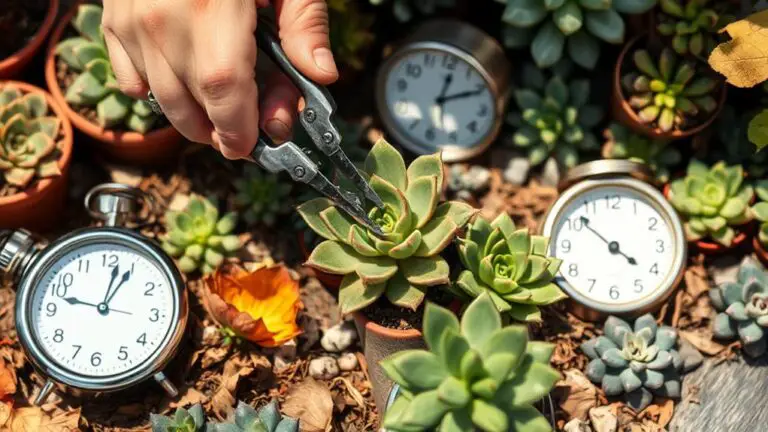7 Essential Tips to Protect Succulents During Rainy Season
When the rainy season hits, your succulents might face challenges they're not accustomed to. You'll need to take specific measures to guarantee they thrive despite the excess moisture. From selecting the right soil to elevating pots for better drainage, each step plays a critical role in their survival. Have you ever wondered how to keep snails at bay or how pumice can enhance your soil mix? There's more to it than just moving your plants indoors. Let's explore the seven essential tips that will keep your succulents healthy and vibrant during those wetter months.
Preparing for Rainstorms

When preparing for rainstorms, it's important to take proactive measures to protect your succulents from potential damage. Start by ensuring your plants are in well-draining soil. This is one of the most significant succulent care tips. Without proper drainage, your succulents might suffer from root rot, especially in prolonged damp conditions.
Consider elevating your succulents or planting them in raised areas to help water run off more easily. You can also use rocks, trenches, or even small umbrellas to direct water away from your plants. These barriers help keep excess water from pooling around your succulents, which can cause damage.
Another effective method is to build shelters using corrugated fiberglass panels or similar materials. These structures can shield your succulents from heavy rain while still allowing good air circulation. This balance is key to prevent your plants from becoming too wet and developing rot.
After a storm, check your succulents for any signs of damage, like squishy leaves. Make sure the soil is drying out properly. If you notice any rot, cut the healthy top growth above the rot to help your plant restart.
With these steps, your succulents will have a better chance of thriving through rainy weather.
Protecting Against Snails
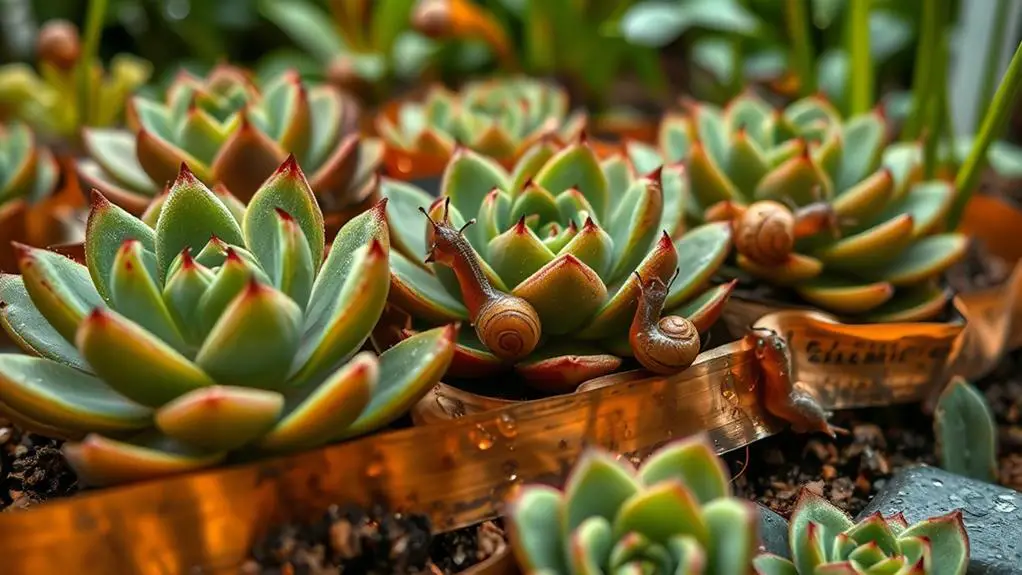
Rainy seasons can turn your garden into a snail haven, posing a serious threat to your succulents. Snails thrive in wet conditions and can quickly damage your plants by leaving unsightly holes in their leaves. To effectively protect succulents, you need to be proactive in managing these pests.
First, closely monitor your plants for any signs of a snail infestation. Snails reproduce rapidly in rainy weather, so regular checks are essential. Look for slime trails or holes in the leaves to catch the problem early.
You can also use environmental control methods like Sluggo bait. It's an effective way to reduce the snail population around your succulents without harming the plants. Before using any control method, make sure to check local regulations, especially if you're considering decollate snails, which may not be legal in all areas.
Here are some practical tips to keep snails at bay:
- Use copper tape: Snails don't like crawling over copper, so placing this tape around your pots can deter them.
- Crush snails with leaves: This method is clean and effective, keeping your shoes and surfaces mess-free.
- Create barriers: Sand or crushed eggshells around the base of plants can make it harder for snails to reach your succulents.
Benefits of Pumice
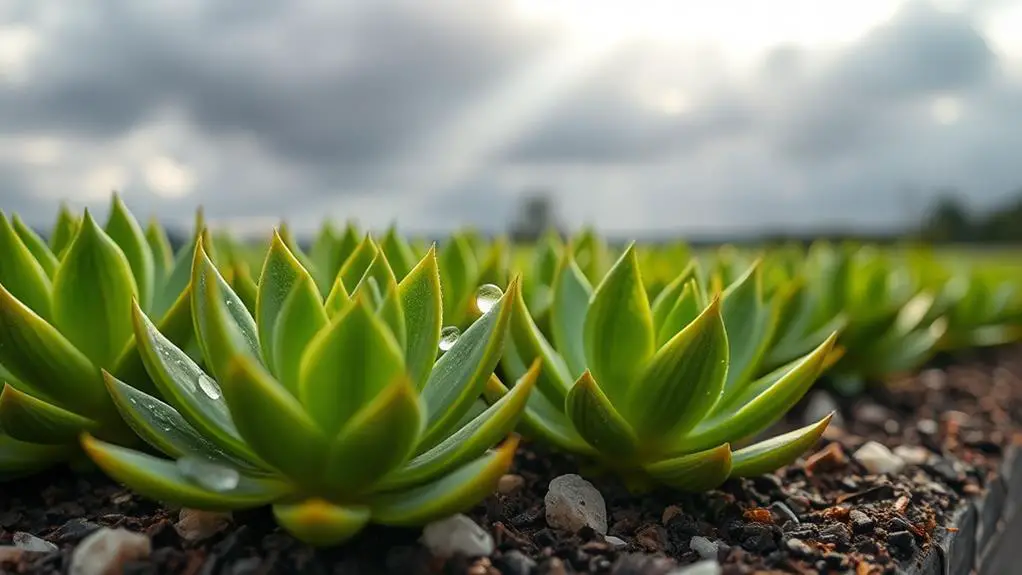
While managing snails is vital for succulent health, you also need to secure the soil conditions are ideal for these resilient plants. One of the best ways to do this is by using pumice.
Pumice is a lightweight volcanic rock that greatly enhances soil aeration and prevents waterlogging. This makes it an ideal amendment for succulent care because these plants need well-draining soil.
When you mix pumice into your potting soil, aim for a ratio of half pumice to guarantee best drainage and moisture retention. This balance allows succulent roots to access oxygen while absorbing excess moisture, reducing the risk of root rot.
For in-ground succulent beds, try combining equal parts of pumice, compost, and garden soil. This mix promotes a healthy balance of nutrients and drainage, helping your succulents thrive.
Using pumice doesn't just enhance drainage; it also maintains a well-draining environment during rainy seasons. By incorporating pumice into your soil, you're creating a more stable environment for your succulents, which is critical when heavy rains threaten to waterlog the soil.
Trust in pumice, and you'll see your succulents flourish even in challenging weather conditions.
Managing Excess Water

Dealing with excess water is essential for keeping your succulents healthy during the rainy season. Too much moisture can cause root rot, which is fatal for these drought-loving plants.
To manage excess moisture, start by identifying low-lying areas in your garden where water tends to accumulate. Avoid planting succulents in these spots to prevent waterlogging.
Elevate your succulent pots above ground level. This helps improve drainage and reduces the risk of water retention in the soil. Additionally, make sure all pots have adequate drainage holes and regularly check that they're clear of mud. This allows excess water to escape effectively and prevents it from sitting around the roots.
Also, plant your succulents in mounded, fast-draining soil. This facilitates efficient water runoff and minimizes puddling around the roots. After heavy rain, be sure to remove any stagnant water from saucers or trays beneath the pots to avoid decay and root rot.
Remember these tips:
- Identify low-lying areas where water accumulates and avoid planting there.
- Elevate pots above ground level to improve drainage.
- Check drainage holes regularly to verify they're clear of mud.
Maximizing Rain Benefits
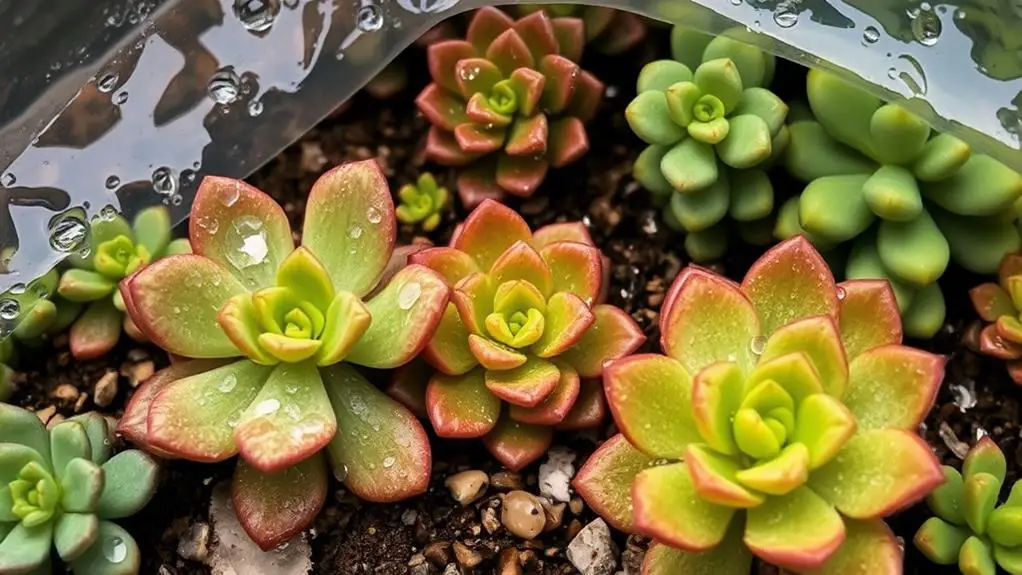
You can really make the most of the rainy season by letting your succulents soak up the nutrients in rainwater.
It not only provides essential minerals and nitrogen but also washes away harmful salts and dust, helping your plants thrive.
Plus, the rain will naturally clean their leaves, improving their ability to absorb light and grow strong.
Rainwater's Nutrient Benefits
During the rainy season, rainwater becomes an important source of nutrients for succulents, providing essential dissolved minerals like calcium and magnesium that are vital for their health and growth.
This natural water is packed with benefits that can help your succulents thrive if you manage it properly.
Rainwater's nutrient benefits go beyond just hydration. It contains nitrogen that promotes healthy foliage and overall plant vigor, which is significant for the care during the monsoon.
Unlike tap water, rainwater helps dilute harmful salts and chemicals, reducing the risk of mineral buildup in the soil. This keeps your succulents' roots healthy and happy.
To make the most out of rainwater, consider these tips:
- Monitor the rainfall: Verify your succulents aren't getting waterlogged by checking how much rain they're receiving.
- Use rain barrels: Collect rainwater in barrels to water your succulents during dry spells, extending the nutrient benefits.
- Elevate pots: Raise your succulent pots to improve drainage and prevent roots from sitting in water.
Dust Removal Efficiency
Amid the rainy season, rainwater plays an essential role in dust removal from succulent leaves, greatly boosting their photosynthesis efficiency.
When rain washes away accumulated dust, more sunlight can reach the chlorophyll, making your succulents healthier and more vibrant. This natural cleaning process also helps rejuvenate leaf surfaces with dissolved minerals, promoting better nutrient absorption.
To maximize dust removal efficiency, guarantee your succulents are positioned where rain can directly reach them. This might mean moving them out from under eaves or other coverings.
Regular dust removal is vital because it prevents the buildup of harmful salts and chemicals that could affect your plants' health. By allowing rain to cleanse the leaves, you're helping your succulents become more resilient against diseases often caused by dust-covered leaves.
Salt Dilution Effect
As rainwater effectively removes dust from succulent leaves, it also plays a significant role in diluting harmful salts and chemicals in the soil. This is vital for maintaining the health of your succulents, especially if you often use tap water, which can lead to salt buildup over time.
Rainwater naturally contains essential minerals and nutrients that improve soil quality and plant health, giving your succulents a much-needed boost.
To make the most of rainwater and minimize salt buildup, consider these tips:
- Collect Rainwater: Set up a simple rainwater collection system to capture and store rainwater for use during dry periods.
- Monitor Soil Quality: Regularly check your soil for signs of salt accumulation, like white crusts on the surface, and use rainwater to flush these salts out.
- Use Mulch: Applying a layer of mulch can help retain moisture and reduce the amount of tap water needed, further preventing salt buildup.
Ensuring Proper Drainage
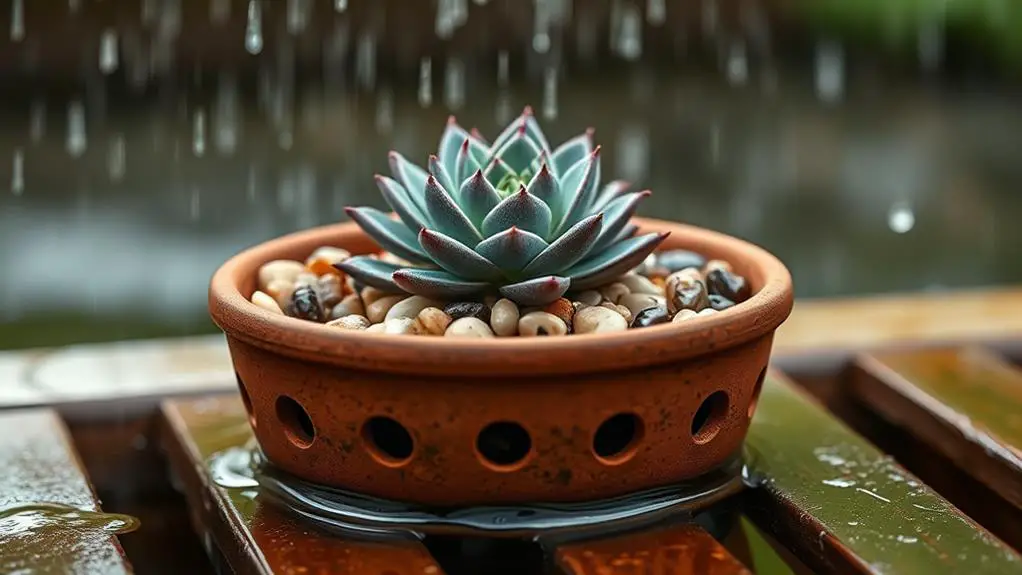
To guarantee your succulents stay healthy during the rainy season, focus on proper drainage techniques.
Make sure your pots have plenty of drainage holes and use well-draining soil mixes like pumice or coarse sand.
Elevate your containers slightly and regularly check the soil moisture levels to prevent waterlogging and root rot.
Soil Drainage Techniques
Proper soil drainage is vital for keeping your succulents healthy, especially during the rainy season. To protect your plants from root rot, make sure you're using containers with drainage holes. These holes are essential because they let excess water escape, preventing it from sitting around the roots and causing damage.
Next, focus on the soil mix. Regular garden soil won't cut it for succulents. Instead, use a well-draining soil mix. You can make this by adding materials like pumice, coarse sand, or gravel. These components help improve aeration and let water pass through quickly, keeping the roots dry and happy.
Here are some practical tips to guarantee excellent soil drainage:
- Check and clear drainage holes: Regularly inspect the drainage holes in your pots. Remove any mud or debris that might clog them and trap water inside.
- Use raised beds or mounds: Planting succulents in raised beds or mounds of fast-draining soil can direct water away from the roots during heavy rain.
- Elevate your pots: While we'll discuss this more later, elevating pots slightly off the ground helps improve airflow and prevents waterlogging.
Elevating Container Plants
Elevating container plants on pot feet or bricks is a simple yet highly effective method to secure proper drainage and prevent root rot. By lifting your succulents off the ground, you enhance air circulation around the pots. This prevents water from accumulating at the bottom, which is vital for avoiding root rot.
First, make certain your pots have adequate drainage holes. These holes let excess water escape, preventing the soil from getting too wet and causing decay.
Adding lightweight materials like pumice to your potting mix can also improve drainage and aeration. This keeps the soil from becoming waterlogged, which is fundamental for healthy succulents.
Placing your elevated pots in well-ventilated areas helps promote evaporation and maintain dryness. This reduces the risk of mold and mildew forming on the soil.
It's also important to regularly check the drainage holes to verify they're not blocked by mud or debris. Blocked holes can hinder proper drainage, leading to over-saturation.
Monitoring Soil Moisture
While elevating your container plants is a great first step, keeping a close eye on soil moisture is equally important during the rainy season. Monitoring soil moisture helps you guarantee that your succulents don't store water for too long, which can lead to root rot.
To check soil moisture, regularly probe the top 2-3 inches of soil with your finger. If it feels dry, your succulents are ready for watering. If it's still damp, hold off on watering to avoid water accumulation. Well-draining soil mixes specifically designed for succulents are essential. These mixes help prevent excess water from sitting around your plant's roots.
It's also vital to confirm that your pots have adequate drainage holes, and you should regularly clean them out to keep water flowing freely. After heavy rainfall, monitor soil conditions closely. Prolonged dampness can harm succulents, so it's often better to replant them in dry soil if necessary.
Here are some quick tips to help you:
- Check soil moisture: Regularly probe the top 2-3 inches.
- Use well-draining soil: Prevents water from accumulating.
- Clear drainage holes: Keeps water flowing freely.
Monitoring Plant Health
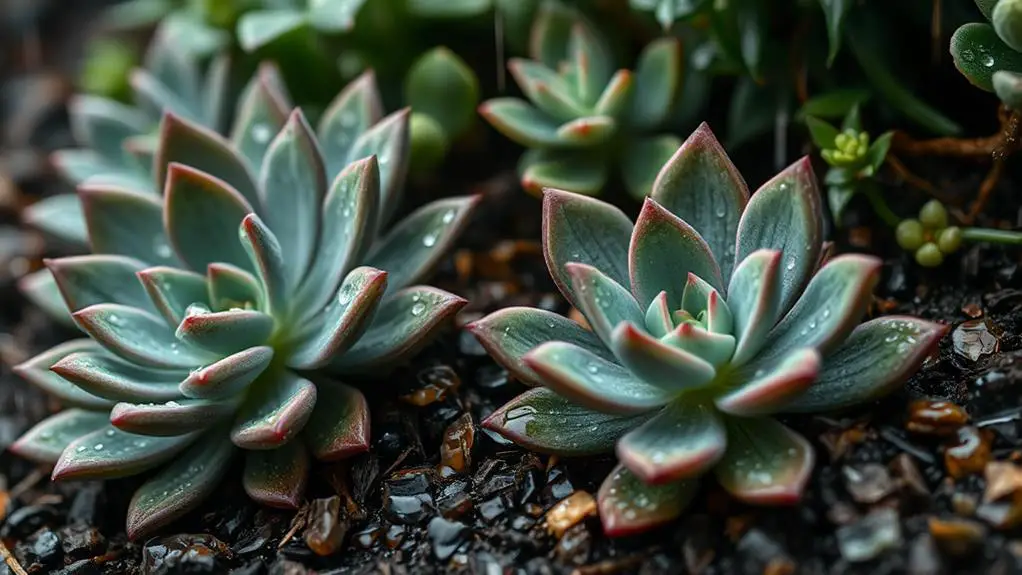
During the rainy season, it's vital to monitor your succulents' health to prevent rot and other issues.
Start by applying the squish test to the leaves. If they feel translucent and pale, these are signs of rot, and you need to act fast.
Inspect the firmness and color of the stem. A healthy stem should be firm and show no discoloration. If you notice any softness, it could indicate underlying problems.
Remove any squishy or damaged leaves promptly to stop the spread of rot. Also, check the roots for damage, and if you find any severely affected plants, discard them to protect the healthy ones.
If the main stem is still intact, carefully dig up the plant. Remove the damaged parts and let the plant dry for a few days in a sheltered area.
Regularly monitoring plant health, especially after heavy rain, is imperative. This helps you catch and address problems early.
By staying vigilant and taking immediate action when you see signs of rot, you'll keep your succulents healthy and thriving during the rainy season.
Stay confident and proactive, and your plants will thank you!
Frequently Asked Questions
How to Protect Succulents From Too Much Rain?
Make certain your succulents are in well-draining soil and pots with drainage holes. Use temporary shelters like umbrellas or move them to covered spots. Regularly check for stagnant water and cut away any damaged leaves to promote health.
What to Do With Succulents During the Rainy Season?
During the rainy season, monitor soil moisture, use temporary shelters, elevate pots, and remove wet leaves promptly. Amend soil with pumice or coarse sand to improve drainage and aeration, ensuring your succulents stay healthy and vibrant.
Can I Leave My Succulents Out in the Rain?
You shouldn't leave your succulents out in the rain. Excessive moisture can cause root rot and make stems and leaves squishy. Instead, move them to covered areas or use shelters like buckets to keep them dry.
How to Protect Succulents From Humidity?
You can protect succulents from humidity by placing them in well-ventilated areas, using fans indoors, and ensuring proper soil drainage. Avoid letting leaves rest on wet surfaces and regularly inspect for signs of mold or mildew.
Conclusion
By following these tips, you'll keep your succulents happy and healthy during the rainy season. Remember to check their soil, elevate their pots, and use barriers to keep snails away. With pumice in your soil mix and shelters to protect from heavy rain, your plants will thrive. Stay vigilant about excess water and always monitor their health. You've got this! Your succulents will thank you for the extra care and attention. Happy gardening!

